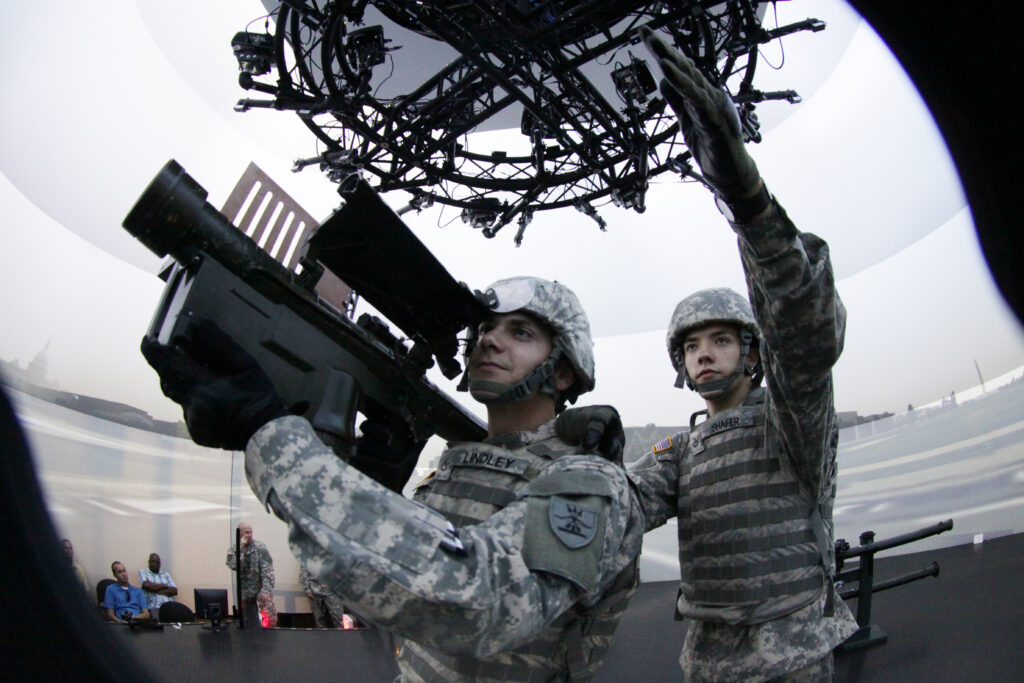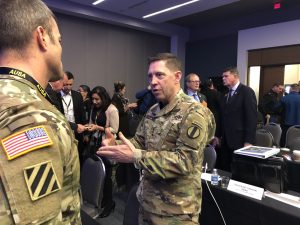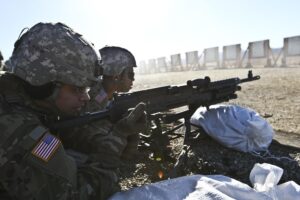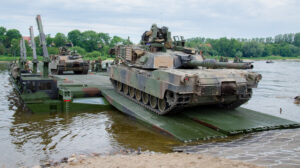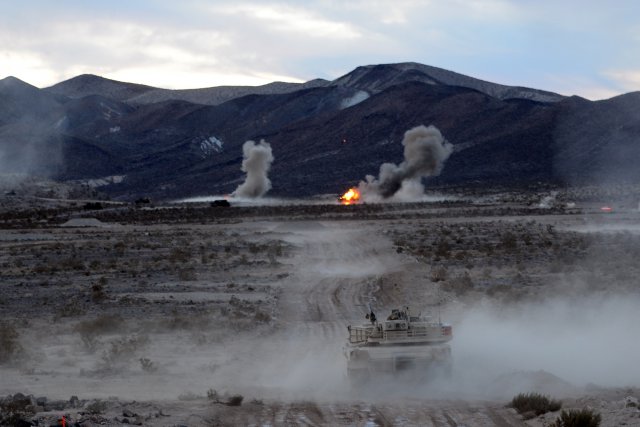How Army’s Multi-Domain Overhaul May Impact The National Guard
Posted on
HUNTSVILLE: Modernizing the Army is about much more than equipment. To defeat Russia and China in future multi-domain warfare — or better yet, deter them — the service is contemplating cultural revolutions as ripe for controversy as any multi-billion dollar weapons program. They include allowing junior officers more initiative, ending chronic micromanagement; creating long-term “regimental” affiliations reminiscent of the British Army, reducing chronic turnover; creating new units and new headquarters, reversing years of HQ cuts; and — potentially most explosive of all — swapping some units between the National Guard and the regular active-duty Army.
“Materiel modernization [is] not so hard as the organizational changes,” the Army’s chief futurist, Lt. Gen. Eric Wesley, told the annual AUSA Global conference here last week.
Flashing proposed org charts on the screen, Army Futures Command’s chief of concepts was quick to emphasize they were early drafts with years of revision and debate before them. (The Army requested we not reproduce the slides in full, precisely because they’re so preliminary; see below for a small slice). “The future force… it will not look like this in the end,” Wesley said. “But we need an azimuth to orient” — a compass bearing to start the long march into the future.
Units on the proposed chart, Wesley explained, are marked in three colors. Green means existing units slated to receive new equipment now being developed under the Army’s Big Six priorities. Blue is new units that might be created or old ones modified beyond recognition. Orange is for formations currently in the Army Reserves or National Guard that might move into the regular Army, replacing part-time citizen-soldiers with full-time troops.
There’s a lot of orange.
Army officials assured me there was no plan to shrink the Reserve or Guard. As some units moved from part-time to full-time, others would go the other way. While they didn’t say what might move into the Guard, I’ve often heard the argument that the Army has far more US-based combat brigades, i.e. infantry and armor, than the Air Force and Navy can deploy quickly to a crisis. (That’s assuming the enemy doesn’t cut off reinforcement altogether). The excess might as well be in the Guard and take a month or more to mobilize, the logic goes, because transport won’t be available before then anyway.
But every unit that moves in either direction is a disruption, not only to the personnel involved but to the prickly political balance within the Army — creating a conflict that could spark outrage on Capitol Hill.
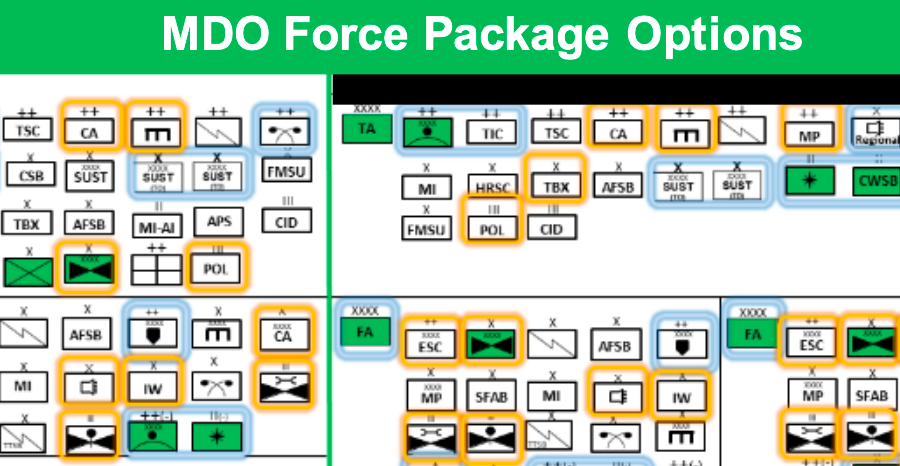
Part of the Army’s early draft for new Multi-Domain formations. Green: existing units to receive new equipment. Blue: new units to be created. Orange: units currently in the National Guard or Reserve that might move to the regular active-duty force.
Going to the Guard
Why move Reserve and Guard units to the regular Army in the first place? The idea is that being manned by full-time troops, with no need call up citizen-soldiers before deployment, makes units more “accessible” for operations. That means, at least in theory, that regulars are more able to deploy rapidly in a crisis — some Guard units, though hardly all, required extensive refresher courses before deploying to Afghanistan or Iraq. It also means, again in theory, regulars are continually available to counter low-grade “gray zone” aggression that doesn’t reach the threshold of open war — although, in practice, both regular and reserve units usually rotate in and out of of forward deployments rather than staying indefinitely.
While the Army hasn’t shared a comprehensive list, the Reserve and Guard units it’s considering converting to regulars seem to be specialist support troops. Some are civil affairs, military police, information operations, and other specialties heavily used in the last 18 years of guerrilla warfare, whose expertise would be highly relevant against the propaganda, proxy warfare, and Little Green Men covert operations perfected by Russia against Ukraine and increasingly practiced by China. Others are logistical and engineering enablers required for large-scale warfare, like bridging units for river crossings and Petroleum, Oil, & Lubricant (POL) units to keep the war moving. A considerable number seem to be aviation units, though it’s not clear whether these are gunships or (more consistent with the others) transport and utility helicopters.
Helicopters were at the heart of the most bitter regular vs. Guard dispute of recent years. The Aviation Restructure Initiative moved Apache gunships from Guard attack units — eliminating some entirely and cutting surviving squadrons from 24 choppers to 18 — to active reconnaissance units as a stopgap replacement for the aging Kiowa scout helicopter. But relations have improved under the current Army Chief of Staff, Gen. Mark Milley, and neither half of the Army is eager for another public blow-up.
“There’s been a significant change for the better in the relationship between Army aviation and Army National Guard aviation,” said retired Brig. Gen. J. Joy Robinson, the president of the powerful National Guard Association of the United States (NGAUS). “But we do have a significant problem on how to equip the ground combat force. The Army still thinks cascading 15 to 20-year-old equipment to the National Guard is considered ‘modernization.’ We vehemently disagree.”
In stark contrast to bitter public feuds over Apaches, Robinson said, Army leaders are now allocating Guard helicopter units a share of cutting-edge new equipment, including 64 new UH-60M Black Hawks in its 2020 budget request. They’ve even said the Guard will receive some of the proposed Future Attack Reconnaissance Aircraft (FARA) at the same time as regular active-duty units. NGAUS calls this approach, in which one Guard unit gets the latest equipment for every six or so comparable active-duty units, “concurrent and proportional” modernization.
But that’s not happening consistently with National Guard ground units, Robinson lamented, even ones on the front line. A Tennessee Guard armored brigade now wrapping up a deployment in Poland — “the closest Army formation, of any component, to Russia,” Robinson noted — is using aging M1A2 Abrams tanks with largely analog electronics, while the active duty is about to field its fourth-generation digital tank, the M1A2 SEP (System Enhancement Package) v4.
“They want to equip the first to fight with the most modern equipment,” Robinson said. “Nobody disagrees with that. What we disagree with is their ability to predict who’s going to be the first to fight.” Besides the old Guard tanks in Poland, he said, there are also more modern Guard tanks just coming home from in Kuwait, Guard helicopters in Afghanistan, and Guard peacekeepers in Bosnia and Kosovo. The Balkan mission, in fact, has been led and largely manned by Guard forces for almost two decades.
Sure, Robinson said when I asked about the proposals to realign support troops, “there may be some requirements that need to be looked at and rebalanced”: His own specialty, combat engineers, at one point had roughly 60 percent of their number in the Guard and Reserves. “There are things the active Army probably will need for sustained presence,” he said, “like going over and actually opening up bases in some of these areas.”
“But in the last 20 years, regardless of the level of conflict, the Guard and Reserve have been part of every operation,” Robinson said. “I think both the nation and the Army are best served when the Army goes to war with all three components — active, Guard and Reserve.”
Sweeping Changes
Swapping units between Guard and regular Army isn’t the only major organizational change the service is considering. Drawing on public briefings and private conservations with a range of officers and experts, here are some of the others:
- Keeping soldiers and officers with the same unit for most of their careers, building strong teams over time, instead of reshuffling them from base to base to base like interchangeable parts. This “regimental or divisional affiliation,” Wesley said, would reduce the constant turnover that hurts readiness today, allowing soldiers and officers to go through multiple training cycles together.
- Focusing specific units on specific regions, e.g. Europe or Asia, with repeated deployments to work with same allies on the same terrain against the same adversaries, instead of trying to make units interchangeable so they can deploy with equal ease (or difficulty) anywhere in the world. “Do we focus BCTs [Brigade Combat Teams] on specific threats or treat them as Legos?” Gen. John Murray, Wesley’s boss, asked at the conference. (While neither general said so, keeping people with the same regionally-focused unit would also help build expertise).
- Creating new units for new missions, such as the intelligence/cyber/targeting battalion (I2CEWS) now at Fort Lewis, or recreating old ones, such as corps-level aerial reconnaissance. Perhaps the hardest sell, because it goes against years of cutting overhead at headquarters, would be new Field Army HQs — the only one today is in Korea — to coordinate large-scale operations, allowing theater commands to focus on the strategic picture. Indo-Pacific Command (INDOPACOM) in particular, Wesley said, might need two subordinate Field Armies, each with its own “package” of multi-domain forces, “because of the sheer size and scale” of the Pacific theater.
One of the biggest changes, however, is not introducing a new idea but making the Army live up to an old one: initiative. For at least a century, the service has been torn between extolling the independent-minded improvisation of the American soldier — something the Guard in particular is known for — and imposing rigid central planning, sometimes at the same time.

Gen. Mark Milley met an enthusiastic welcome from the National Guard Association of the US (NGAUS) at its 2016 conference.
In 2009, the Army officially replaced “command and control” with “mission command,” which requires leaders to give their subordinates a clear vision of the objective but plenty of leeway on how to achieve it. The idea dates back 200 years to when the Prussians learned how to beat Napoleon, led Germany to some striking if short-lived victories in two world wars, and has since spread to other nations. Swedish peacekeepers in Bosnia, for example, disregarded orders from the UN and their own government in their determination to protect both themselves and local civilians. The Army Chief of Staff, Gen. Milley, seems to be thinking much the same way: In 2016, he declared that the chaos of future battlefields — unplanned-for threats, fleeting opportunities, and frequent breakdowns in communications — would at times require “the willingness to disobey specific orders.”
But the culture of micromanagement and rigid plans remains stronger in the US Army than initiative-driven mission command. “We talk about it a lot, but… we don’t do it well,” Lt. Gen. Wesley said. (He’s written extensively on this theme). The official doctrine is sound, he told the AUSA conference, but commanders all too often keep their subordinates on a tight leash, one that would snap under the strains of high-intensity combat.
That has to change. “In the future, we believe we’re going to require mission command … on a scale our generation has never seen,” Wesley said. That requires more than new org charts or doctrinal manuals, he warned: It means “completely changing the culture.”
Subscribe to our newsletter
Promotions, new products and sales. Directly to your inbox.

